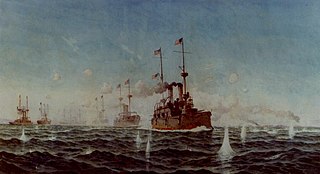
The Battle of Manila Bay, also known as the Battle of Cavite, took place on 1 May 1898, during the Spanish–American War. The American Asiatic Squadron under Commodore George Dewey engaged and destroyed the Spanish Pacific Squadron under Contraalmirante Patricio Montojo. The battle took place in Manila Bay in the Philippines, and was the first major engagement of the Spanish–American War. The battle was one of the most decisive naval battles in history and marked the end of the Spanish colonial period in Philippine history.

SS Saint Paul was a trans-Atlantic ocean liner named for the capital of Minnesota.

The Puerto Rico campaign was the American military sea and land operation on the island of Puerto Rico during the Spanish–American War. The offensive began on May 12, 1898, when the United States Navy attacked the capital, San Juan. Though the damage inflicted on the city was minimal, the Americans were able to establish a blockade in the city's harbor, San Juan Bay. On June 22, the cruiser Isabel II and the destroyer Terror delivered a Spanish counterattack, but were unable to break the blockade and Terror was damaged.
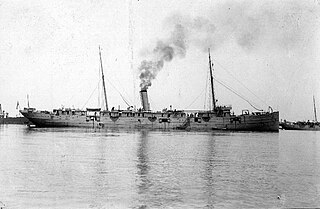
The first USS Yosemite was an auxiliary cruiser of the United States Navy. Built as El Sud in 1892 by Newport News Shipbuilding and Dry Dock Company, in Newport News, Virginia for the Southern Pacific Railroad's Morgan Line. The Navy acquired El Sud on 6 April 1898, at the beginning of the Spanish–American War and renamed her Yosemite. It commissioned her on 13 April 1898 under Commander William H. Emory.
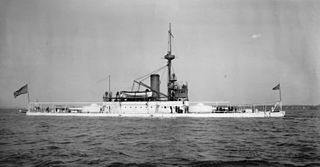
USS Terror —the totally rebuilt version of the earlier monitor Agamenticus, which had shared the Terror's name—was an iron-hulled, twin-screw, double-turreted monitor of the Amphitrite class; on June 23, 1874 by order of President Ulysses S. Grant's Secretary of Navy George M. Robeson in response to the Virginius Incident laid down at Philadelphia contracted by William Cramp & Sons. Her construction progressed over the next three years until suspended in 1877. Work was resumed six years later, and the monitor was launched on 24 March 1883.

The second USS Suwannee and third USS Mayflower was a United States Lighthouse Board, and later United States Lighthouse Service, lighthouse tender transferred to the United States Navy in 1898 for service as an auxiliary cruiser during the Spanish–American War and from 1917 to 1919 for service as a patrol vessel during World War I. She also served the Lighthouse Board and in the Lighthouse Service as USLHT Mayflower from 1897 to 1898, from 1898 to 1917, and from 1919 to 1939, and in the United States Coast Guard as the first USCGC Mayflower (WAGL-236) in 1939 and from 1940 to 1943 and as USCGC Hydrangea (WAGL-236) from 1943 to 1945.
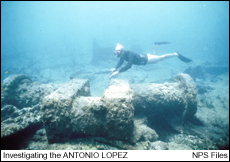
The Antonio López was a historic vessel of the Spanish merchant marine. When built in 1881–82, she was the first Spanish-built steel merchant vessel with a complete electrical lighting system. She was also one of the most important Spanish blockade-runners during the American blockade of (then-Spanish) Puerto Rico during the Spanish–American War, its crew delivering a supply of military materials critical to the island's defense after the ship was grounded in June 1898 under fire from the Americans. The shipwreck is the only known Spanish wreck in American waters from the conflict. Its wreck site, in 1,700 feet (520 m) of water off Dorado, Puerto Rico, was designated a National Historic Landmark in 1997.

Almirante Oquendo, was an Infanta Maria Teresa-class armored cruiser of the Spanish Navy that fought at the Battle of Santiago de Cuba during the Spanish–American War.

Infanta María Teresa was the lead ship of her class of armoured cruiser constructed for the Spanish Navy. The ship fought at the Battle of Santiago de Cuba during the Spanish–American War.
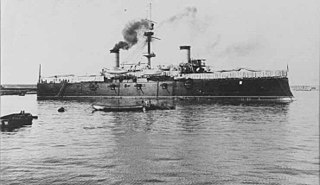
Cristóbal Colón was a Giuseppe Garibaldi-class armored cruiser of the Spanish Navy that fought at the Battle of Santiago de Cuba during the Spanish–American War.
Plutón was a Furor-class destroyer of the Spanish Navy that fought at the Battle of Santiago de Cuba during the Spanish–American War.

Furor was a Furor-class destroyer of the Spanish Navy that fought at the Battle of Santiago de Cuba during the Spanish–American War.

Terror was a Furor-class destroyer of the Spanish Navy that fought at San Juan, Puerto Rico during the Spanish–American War. Constructed in the United Kingdom, the ship entered service in 1896 and was significantly damaged at the Second Battle of San Juan in 1898. In 1920, the destroyer was converted to a minelayer and discarded in 1924.

Isabel II was a Velasco-class unprotected cruiser of the Spanish Navy, named after Queen Isabella II. The ship fought at San Juan, Puerto Rico, during the Spanish–American War.

General Concha was a General Concha-class Cañonero (gunboat) or more technically "Third Class non-armored Cruiser" of the Spanish Navy which fought at San Juan, Puerto Rico, during the Spanish–American War.

The Flying Squadron was a United States Navy force that operated in the Atlantic Ocean, the Gulf of Mexico and the Spanish West Indies during the first half of the Spanish–American War. The squadron included many of America's most modern warships which engaged the Spanish in a blockade of Cuba.
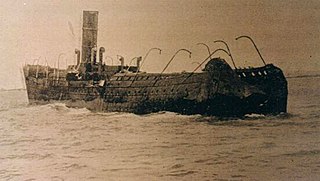
The Third Battle of San Juan began on 28 June 1898 when an American auxiliary cruiser intercepted a Spanish blockade runner. A Spanish squadron attempted to rescue the blockade runner and succeeded in taking off supplies and her crew but failed to save the ship, which the American warship engaged and forced to run aground.

The Bombardment of San Juan, or the First Battle of San Juan, on 12 May 1898 was an engagement between United States Navy warships and the Spanish fortifications of San Juan, Puerto Rico. It was the first major action of the Puerto Rican Campaign during the Spanish–American War.

The action of 13 June 1898 was a minor naval engagement of the Spanish–American War fought near Cienfuegos, Cuba, between the American auxiliary cruiser USS Yankee under Commander Willard Herbert Brownson and the Spanish gunboat Diego Velázquez under Teniente de Navío de 1ª clase Juan de Carranza y Reguera, which had exited the port to inspect a suspicious steamer which proved to be Yankee. Diego Velázquez, markedly inferior to Yankee in armament, managed to return to Cienfuegos, where it was joined by the small gunboats Lince and Cometa. After the appearance of the latters, Yankee decided to withdraw.

The Furor class was a type of destroyers of the Spanish Navy, similar to the units of the A class, or 27 knotters, of the British Royal Navy. Commissioned in 1896 by the then Minister of the Navy Admiral Beranger after the success of the design by Fernando Villaamil of the warship Destructor, which had given name to a whole typology of vessels.


















